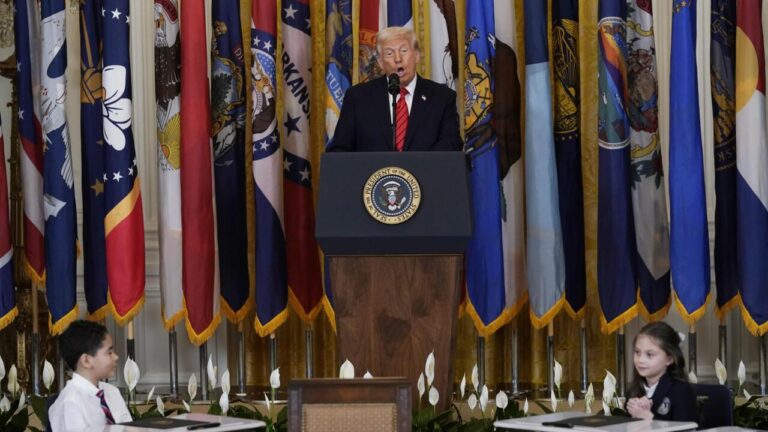In a surprising move that has sparked intense debate across the nation, former President Donald Trump has signed an executive order aimed at shuttering the U.S. Department of Education. The directive, unveiled late Tuesday, outlines plans to dismantle the federal agency responsible for overseeing public education and redistributing its functions to state and local governments. Critics and supporters alike are weighing in on the implications of this unprecedented step, which marks a dramatic shift in federal education policy and raises questions about the future of nationwide standards and funding.
Trump Unveils Executive Order Targeting Education Department Closure
The executive order signed by former President Donald Trump sets in motion plans that could fundamentally transform the federal government’s role in education. The proposal calls for a phased closure of the Department of Education, aiming to shift its responsibilities to state governments and private entities. Advocates of the move argue it will reduce federal overreach and increase local control, but critics warn it could disrupt funding and widen educational inequality across the country.
Key elements outlined in the order include:
- Reallocation of funding to states: Grant programs would be transferred to state control, allowing for tailored education policies.
- Reduction in federal regulations: Eliminating certain mandates currently enforced by the department.
- Support for school choice initiatives: Increased backing for charter schools and voucher programs.
| Timeline | Major Action | Expected Impact |
|---|---|---|
| 0-6 months | Initial budget reallocation | States begin receiving direct funding |
| 6-18 months | Regulatory rollbacks | Reduction in federal compliance requirements |
| 18-36 months | Department phase-out | Transition to local governance fully implemented |
Implications for Federal Education Funding and Policy Frameworks
The executive order signed by President Trump signals a monumental shift in the landscape of federal education funding, with profound consequences for states and school districts nationwide. By targeting the Department of Education for closure, the administration aims to redistribute funding mechanisms, potentially diminishing direct federal oversight and reallocating these resources through block grants to states. This approach could substantially increase state autonomy, but raises concerns about the consistency and equity of educational opportunities across the country.
Key implications include:
- Decentralization of funds: States would gain more discretion in allocating education dollars, tailoring programs to local needs but risking uneven quality and support.
- Reduction in federal enforcement: Enforcement of civil rights and anti-discrimination policies in schools may weaken without a centralized federal authority.
- Impact on accountability frameworks: The elimination of federal standardized assessments and reporting may challenge efforts to monitor educational outcomes nationwide.
| Category | Current Role (DOE) | Potential Change |
|---|---|---|
| Funding Allocation | Distributes federal grants directly | States manage block grants |
| Compliance Enforcement | Monitors civil rights in education | Reduced federal oversight |
| Accountability & Reporting | Mandates nationwide standardized testing | Shift to state-designed metrics |
Reactions from Educators and Lawmakers Across the Political Spectrum
Educators from various backgrounds expressed mixed reactions to the unprecedented move. While some teachers and school administrators praised the president’s efforts as a step toward decentralizing control and empowering local authorities, others voiced concerns about the potential chaos that could ensue from dismantling an institution that provides federal guidance and funding. Union leaders warned that this order might undermine nationwide educational standards and exacerbate inequalities across districts.
- Supporters: Advocated for greater local control and reduced federal bureaucracy.
- Opponents: Feared loss of critical funding and support programs for disadvantaged students.
- Neutral voices: Called for a detailed transition plan to prevent disruption in schools.
Lawmakers’ responses cut sharply along party lines but also revealed some surprising overlaps. Republican members largely applauded the move as fulfilling campaign promises, emphasizing fiscal responsibility and states’ rights. Conversely, Democratic lawmakers condemned the order as reckless and potentially harmful to students nationwide. However, a handful of bipartisan voices urged for a thorough debate in Congress before any implementation, highlighting the complex implications for education policy and equity.
| Political Affiliation | General Position | Key Concerns |
|---|---|---|
| Republican | Supportive | Federal overreach, budget savings |
| Democrat | Opposed | Student protections, funding loss |
| Independent | Cautious | Policy impacts, transition clarity |
Potential Alternatives and Recommendations for Education System Reform
In light of the recent executive order targeting the closure of the Education Department, experts and policymakers have begun exploring alternatives that could decentralize control while enhancing educational outcomes. One prominent proposal suggests returning more authority to state and local governments, allowing for tailored curricula that better reflect community values and needs. Advocates argue this would empower districts to innovate without the constraints of federal mandates, potentially resulting in more effective and context-sensitive educational strategies.
Simultaneously, recommendations increasingly emphasize partnerships with private and nonprofit sectors to inject competition and fresh ideas into the system. Key initiatives under consideration include:
- School vouchers to increase parental choice
- Expanded charter school programs focused on accountability
- Investment in technology to personalize learning experiences
- Enhanced teacher training through private-public collaborations
| Reform Model | Pros | Cons |
|---|---|---|
| Decentralization | Local control, innovation | Inconsistent standards |
| Public-Private Partnerships | Increased resources, expertise | Equity concerns |
| Tech Integration | Personalized learning, engagement | Digital divide risks |
Closing Remarks
As the Trump administration moves forward with its controversial plan to dismantle the Department of Education, debates intensify over the future of federal involvement in schooling. Supporters argue the move will reduce bureaucracy and empower local control, while critics warn it could undermine educational equity and access. The coming months will reveal how this unprecedented directive unfolds amid legal challenges and political pushback, reshaping the landscape of American education.




